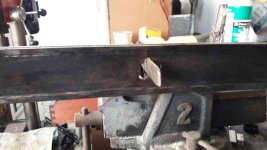I don't know the correct way to sharpen a blade, but I'll describe mine... what's yours?
In fact, sharpening is not a very important item for many users, because even if the blade is not sharp, the cutter will shred the grass or any tree leaf... but the result is not satisfactory, in addition to causing greater consumption with more passes and even damage to the deck as a whole.
To those who don't sharpen, but change it after noticing an inefficiency, congratulations... it's the most correct way... but expensive.
Let's go...
With the blade off the deck, clamp it with a clamp on the workbench and clean (rust, glued and dry grass, animal manure, etc...), on all surfaces, using a grinder with flap disc, wire disc, etc.
After cleaning, I change the disk for an iron grinding disk (carburundum, diamond, aggressive flap, etc...) and grind at approximately 45° until I get a good edge.
After satisfactory sharpening, I move on to the balancing stage, an important procedure to keep the deck serene, without unnecessary vibrations that can cause loosening of screws, premature wear of pulley bearings, noise, etc.
To do this, just fix a rod with a rounded profile in a vise or workbench and hang the blade through its hole... the photos speak for themselves...
Cleaning the blade


Cleaning up will make balancing easier at the end.
Sharpening...

Balancing
Blade one...

Very good...

Bade two...
Oops! Necessary adjustment...
Mark the side and remove material to make it lighter... preferably not on the sharp part.




Until equilibrium is achieved, several attempts can be made...
The end of the blade must be given special care, as it is the first to attack the grass... in any case, the edge is lost along the entire stretch due to stones, stumps, sand, sidewalks, hard fruit seeds and other objects. ..
In fact, sharpening is not a very important item for many users, because even if the blade is not sharp, the cutter will shred the grass or any tree leaf... but the result is not satisfactory, in addition to causing greater consumption with more passes and even damage to the deck as a whole.
To those who don't sharpen, but change it after noticing an inefficiency, congratulations... it's the most correct way... but expensive.
Let's go...
With the blade off the deck, clamp it with a clamp on the workbench and clean (rust, glued and dry grass, animal manure, etc...), on all surfaces, using a grinder with flap disc, wire disc, etc.
After cleaning, I change the disk for an iron grinding disk (carburundum, diamond, aggressive flap, etc...) and grind at approximately 45° until I get a good edge.
After satisfactory sharpening, I move on to the balancing stage, an important procedure to keep the deck serene, without unnecessary vibrations that can cause loosening of screws, premature wear of pulley bearings, noise, etc.
To do this, just fix a rod with a rounded profile in a vise or workbench and hang the blade through its hole... the photos speak for themselves...
Cleaning the blade


Cleaning up will make balancing easier at the end.
Sharpening...

Balancing
Blade one...

Very good...

Bade two...
Oops! Necessary adjustment...
Mark the side and remove material to make it lighter... preferably not on the sharp part.




Until equilibrium is achieved, several attempts can be made...
The end of the blade must be given special care, as it is the first to attack the grass... in any case, the edge is lost along the entire stretch due to stones, stumps, sand, sidewalks, hard fruit seeds and other objects. ..
Attachments
Last edited:




